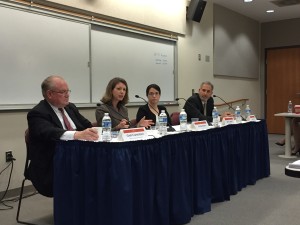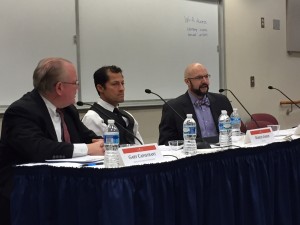On March 31, the Health Law and Justice Society hosted its spring symposium “Drug Promotion in the 21st Century: Off-Label Marketing and First Amendment Concerns.”
Although the Food and Drug Administration (FDA) approves drugs for specific medical purposes, many treatments approved for one use are also effective for other diseases and conditions. The FDA has traditionally prohibited the promotion of medical products for uses other than those approved by the agency and reflected in the labeling. This restriction, however, has recently been weakened by successful legal challenges based on the First Amendment guarantee of freedom of speech. The symposium provided an overview of these issues and assessed recent legal developments, including several important cases decided in the past year. The panelists also discussed the implications of expanding the right to off-label promotion for the FDA, the drug industry, and medical practice. Professor Lewis Grossman, Professor of Law at American University Washington College of Law and food and drug law scholar, introduced and moderated the panel.
The speakers for the symposium were 1) Allison Zieve, J.D., Director, Public Citizen Litigation Group; 2) Richard Samp, J.D., Chief Counsel, Washington Legal Foundation; 3) Adriane Fugh-Berman, M.D., Associate Professor and Director of PharmedOut, Georgetown University Medical Center; and 4) Anne K. Walsh, J.D., Director, Hyman, Phelps & McNamara, P.C.
Ms. Zieve offered an illustrative history of how FDA’s authority over drugs has evolved. Her comments focused on the FDA’s requirements of safety and efficacy for new drugs before approval for sale on the market and balancing that with what is considered “truthful” speech. She emphasized that laypeople may not be able to properly evaluate truthful scientific statements in terms of safety and efficacy for human use. Furthermore, she stated that allowing industry to successfully use the First Amendment to discuss truthful statements about off-label uses of drugs could potentially have severe consequences for the public.
Mr. Samp’s comments focused on truthful speech, and regulations of commercial speech. He emphasized that the current trend in courts is to apply closer First Amendment scrutiny to restrictions on non-misleading commercial speech.
Ms. Fugh-Berman brought a physician’s and academic perspective on this issue. Among many things, she discussed the fact that while off-label uses of drugs can sometimes be rational and inevitable, most of the time, it is not. She focused on scientific support for off-label uses of drugs. She said that industry controls what information and studies the public sees and that companies usually have a great deal of information regarding off-label uses of their drugs.
Finally, Ms. Walsh’s comments discussed the interplay between the Federal Food, Drug, and Cosmetic Act, and the False Claims Act.
The symposium was an incredible event with truly esteemed speakers. The AUWCL community was incredibly lucky to have such knowledgeable speakers come and offer their expertise. To watch the event and hear further details, please visit: http://media.wcl.american.edu/Mediasite/Play/5a8de06dc577415b84aee30771df3e111d.


